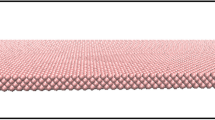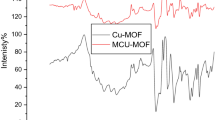Abstract
A novel cationic surfactant type of N'alkyl N,'N'dimethyl-4-morpholino-4-oxobutanoylhydrazinium iodide (10a–12a) and N'alkyl N', N'dimethyl-4-piperidino-4-oxobutanoylhydrazinium iodide (10b–12b) of quaternary hydrazinium moieties in hydrophilic parts was synthesized. These quaternary hydrazinium surfactants were obtained using a two-step reaction scheme, starting from ring opening of succinic anhydride with a base (morpholine, piperidine), followed by ammonolysis with hydrazine hydrate, then alkylation of the amino group with alkyl bromides (RBr) that have different hydrophobic chain lengths (R, C12H25, C14H29, and C16H37), and ending with the quaternarization of the secondary amino group by two moles of methyl iodide. The chemical composition of the surfactants was analyzed by FTIR, 1HNMR, mass spectroscopy, and elemental analysis. A variety of surface-active characteristics were achieved by surface calculations, including CMC, γcmc, CMC/C20, Γmax, pC20, Amin, and Πcmc. These surface characteristics and foam stability rely on the nature of the hydrophobic chain. Preliminary results showed that an upgrade throughout the CH2 group in the fatty chain and the morpholine or piperidine ring lowers the CMC and increases the foaming capacity and stability of the quaternary hydrazinium surfactants. Anionic dye (Acid BG) interactions with 12b surfactant (as an example) were studied using the spectrophotometric technique and the binding constant (170.64 dm3.mol−1) was determined. The results indicate solubilization and binding took place at a large scale. Furthermore, considerable biodegradation of cationic surfactants was observed (68–87%). The antimicrobial activity of these surfactants has also been observed with the minimum inhibitory concentration (MIC) and the size of inhibited growth zone. The smallest MICs were found in 12a (64 µg/mL) and 12b (32 µg/mL) surfactants, indicating the highest antimicrobial activity.








Similar content being viewed by others
References
J. Węgrzyńska, J. Chlebicki, I. Maliszewska, Preparation, surface-active properties and antimicrobial activities of bis(ester quaternary ammonium) salts. J. Surfactants Deterg. 10(2), 109–116 (2007)
L. Wang, H. Qin, L. Ding, S. Huo, Q. Deng, B. Zhao, L. Meng, T. Yan, Preparation of a novel class of cationic gemini imidazolium surfactants containing amide groups as the spacer: their surface properties and antimicrobial activity. J. Surfactants Deterg. 17(6), 1099–1106 (2014)
A. Kanazawa, T. Ikeda, T. Endo, Synthesis and antimicrobial activity of dimethyl- and trimethyl-substituted phosphonium salts with alkyl chains of various lengths. Antimicrob. Agents Chemother. 38(5), 945–952 (1994)
P. Foley, A. Kermanshahi Pour, E. Beach, J. Zimmerman, Derivation and synthesis of renewable surfactants. Chem. Soc. Rev. 41(4), 1499–1518 (2012)
L. Schramm, E. Stasiuk, D. Marangoni, 2-Surfactants and their applications. Annu. Rep. Prog. Chem. Sect. C: Phys. Chem. 99, 3–48 (2003)
Y. Guo, Y. Li, B. Zhi, D. Zhang, Y. Liu, Q. Huo, Effect of cationic surfactants on structure and morphology of mesostructured MOFs. RSC Adv. 2(12), 5424 (2012)
D. Asefi, M. Arami, N.M. Mahmoodi, Electrochemical effect of cationic gemini surfactant and halide salts on corrosion inhibition of low carbon steel in acid medium. Corros. Sci. 52, 794–800 (2010)
Q. Liu, M. Guo, Z. Nie, J. Yuan, J. Tan, S. Yao, Spacer-mediated synthesis of size-controlled gold nanoparticles using geminis as ligands. Langmuir 24, 1595–1599 (2008)
I. Badea, S. Wettig, R. Verrall, Foldvari, Topical non-invasive gene delivery using gemini nanoparticles in interferon-γ-deficient mice. M Eur. J. Pharm. Biopharm. 65, 414–422 (2007)
Y. Jiang, Y. Luan, F. Qin, L. Zhao, Z. Li, Catanionic vesicles from an amphiphilic prodrug molecule: a new concept for drug delivery systems. RSC Adv. 2, 6905–6912 (2012)
L. Perez, A. Pinazo, M.T. Garcia, M. Lozano, A. Manresa, M. Angelet, M.P. Vinardell, M. Mitjans, R. Pons, Infante, M. R. Cationic surfactants from lysine: synthesis, micellization and biological evaluation. Eur. J. Med. Chem. 44, 1884–1892 (2009)
C. Corless, G. Reynolds, N. Graham, R. Perry, T. Gibson, J. Haley, Aqueous ozonation of a quaternary ammonium surfactant. Water Res. 23(11), 1367–1371 (1989)
S. Giolando, R. Rapaport, R. Larson, T. Federle, M. Stalmans, P. Masscheleyn, Environmental fate and effects of DEEDMAC: a new rapidly biodegradable cationic surfactant for use in fabric softeners. Chemosphere 30(6), 1067–1083 (1995)
O. Kirk, F. Pedersen, C. Fuglsang, Preparation and properties of a new type of carbohydrate-based cationic surfactant. J. Surfactants Deterg. 1(1), 37–40 (1998)
T. Tatsumi, W. Zhang, T. Kida, Y. Nakatsuji, D. Ono, T. Takeda, I. Ikeda, Novel hydrolyzable and biodegradable cationic gemini surfactants: 1,3-bis[(acyloxyalkyl)-dimethylammonio]-2-hydroxypropane dichloride. J. Surfactants Deterg. 3(2), 167–172 (2000)
P.E. Hellberg, Ortho ester-based cleavable cationic surfactants. J. Surf. Deterg. 5, 217 (2002)
Z. Miao, J. Yang, L. Wang, Y. Liu, L. Zhang, X. Li, L. Peng, Synthesis of biodegradable lauric acid ester quaternary ammonium salt cationic surfactant and its utilization as calico softener. Mater. Lett. 62, 3450 (2008)
J. Lim, E. Kang, H. Lee, B. Lee, Synthesis and interfacial properties of ethoxylated cationic surfactants derived from n-dodecyl glycidyl ether. J. Ind. Eng. Chem. 22, 75–82 (2015)
A. Pinazo, M. Manresa, A. Marques, M. Bustelo, M. Espuny, L. Pérez, Amino acid–based surfactants: new antimicrobial agents. Adv. Coll. Interface. Sci. 228, 17–39 (2016)
E.M. Kandeel, M.R. El-Din, E.E. Badr, M.R. Mishrif, H.G. Nasr Mohamed, Synthesis and evaluation of new anionic Gemini dispersants as oil dispersants to treat crude oil spill pollution. J. Surfactants Deterg. 23(4), 753–770 (2020)
A. Bhadani, T. Misono, S. Singh, K. Sakai, H. Sakai, M. Abe, Structural diversity, physicochemical properties and application of imidazolium surfactants: recent advances. Adv. Coll. Interface. Sci. 231, 36–58 (2016)
P. Patial, A. Shaheen, I. Ahmad, Synthesis of ester based cationic Pyridinium Gemini surfactants and appraisal of their surface active properties. J. Surfactants Deterg. 16(1), 49–56 (2012)
A. Bhadani, T. Okano, T. Ogura, T. Misono, K. Sakai, M. Abe, H. Sakai, Structural features and surfactant properties of core–shell type micellar aggregates formed by Gemini piperidinium surfactants. Coll. Surf., A 494, 147–155 (2016)
B. Cai, X. Li, Y. Yang, J. Dong, Surface properties of gemini surfactants with pyrrolidinium head groups. J Coll Interface Sci 370, 111–116 (2012)
A. Bhadani, M. Tani, T. Endo, K. Sakai, M. Abe, H. Sakai, New ester based gemini surfactants: the effect of different cationic headgroups on micellization properties and viscosity of aqueous micellar solution. Phys. Chem. Chem. Phys. 17(29), 19474–19483 (2015)
E.E. Badr, Preparation, surface-active properties and antimicrobial activities of cationic surfactants based on morpholine and piperidine. Adv. Appl. Sci. Res. 8(2), 81–89 (2017)
R. Kamboj, S. Singh, V. Chauhan, Synthesis, characterization and surface properties of N-(2-hydroxyalkyl)-N-(2-hydroxyethyl)imidazolium surfactants. Coll Surf. A: Physicochem Eng. Asp. 441, 233–241 (2014)
Z.H. Asadov, A.H. Tantawy, I.A. Zarbaliyeva, R.A. Rahimov, Synthesis of new surface-active ammonium-type complexes based on palmitic acid for removing thin petroleum films from water surface. Egypt. J. Pet. 22(2), 261–267 (2013)
W.H. Ansari, N. Fatma, M. Panda, Kabir-ud-Din. , Solubilization of polycyclic aromatic hydrocarbons by novel biodegradable cationic gemini surfactant ethane-1,2-diyl bis(N, N-dimethyl-N-hexadecylammoniumacetoxy) dichloride and its binary mixtures with conventional surfactants. Soft Matter 9(5), 1478 (2013)
A.R. Tehrani-Bagha, K. Holmberg, Cationic ester-containing gemini surfactants: physical−chemical properties. Langmuir 26(12), 9276–9282 (2010)
J. Hoque, S. Gonuguntla, V. Yarlagadda, V.K. Aswal, J. Haldar, Effect of amide bonds on the self-assembly of gemini surfactants. Phys. Chem. Chem. Phys 16(23), 11279–11288 (2014)
M. Wang, Y. Han, F. Qiao, Y. Wang, Aggregation behavior of a gemini surfactant with a tripeptide spacer. Soft Matter 11(8), 1517–1524 (2015)
E.W. Schmidt, Hydrazine and Its Derivatives Preparation Properties and Applications (Wiley, New York, 1984).
B.N. Sivasankar, S. Govindarajan, Acetate and malonate complexes of cobalt(II), nickel(II) and zinc(II) with hydrazinium cation. J. Therm. Anal. 48(6), 1401–1413 (1997)
K.C. Patil, J.P. Vittal, C.C. Patel, Syntheses and thermal decompositions of hydrazinium salts. J. Therm. Anal. 26(2), 191–198 (1983)
A. Ali, F. Nabi, N.A. Malik, S. Tasneem, S. Uzair, Study of micellization of sodium dodecyl sulfate in non-aqueous media containing lauric acid and dimethylsulfoxide. J. Surfactants Deterg. 17(1), 151–160 (2013)
J. Ribe, J. Cegarra, L. Aizpurúa, The influence of ionic surface-active agents on the dyeing of hercosett wool with α-bromoacrylamide dyes. J. Soc. Dyers Colour. 99(12), 374–382 (2008)
A.M. Misselyn-Bauduin, A. Thibaut, J. Grandjean, G. Broze, R. Jérôme, Mixed micelles of anionic−nonionic and anionic−zwitterionic surfactants analyzed by pulsed field gradient NMR. Langmuir 16(10), 4430–4435 (2000)
J. Falbe, Surfactants in Consumer Products: Theory Technology and Application (Springer, Germany, 2012).
B. Brycki, Z. Dega-Szafran, I. Mirska, Synthesis and antimicrobial activities of some quaternary morpholinium chlorides. Pol. J. Microbiol. 59(1), 49–53 (2010)
M.J. Rosen, Surfactants and Interfacial Phenomena (Wiley-Interscience, 1989).
A. Sokołowski, J. Chlebicki, K.A. Wilk, Adsorption of oligooxypropylenated amines at the aqueous solution—air interface: homologous series of piperidine and morpholine derivatives. Coll. Surf. A: Physicochem. Eng. Asp. 80(2–3), 243–249 (1993)
M.T. Garcia, O. Kaczerewska, I. Ribosa, B. Brycki, P. Materna, M. Drgas, Hydrophilicity and flexibility of the spacer as critical parameters on the aggregation behavior of long alkyl chain cationic Gemini surfactants in aqueous solution. J. Mol. Liq. 230, 453–460 (2017)
E.M. Lee, R.K. Thomas, J. Penfold, R.C. Ward, Structure of aqueous decyltrimethylammonium bromide solutions at the air water interface studied by the specular reflection of neutrons. J. Phys. Chem. 93(1), 381–388 (1989)
P.A. Pires, O.A. El Seoud, Surfactants with an amide group “spacer”: Synthesis of 3-(acylaminopropyl)trimethylammonium chlorides and their aggregation in aqueous solutions. J. Coll. Interface Sci. 304(2), 474–485 (2006)
S. Shapovalov, V. Ponomariov, Interaction of dyes with cationic surfactants in solutions: determination of critical micelle concentration. Int. Lett. Chem. Phys. Astron. 81, 27–34 (2019)
N.A. Al-Omair, Thermodynamic study of interaction between a cationic surfactant and an anionic azo dye in aqueous solution. J. Indian Chem. Soc 93, 1–7 (2016)
H. Akbaş, T. Taner, Spectroscopic studies of interactions between C. I. reactive orange with alkyltrimethylammonium bromide surfactants. Spectrochimica Acta Part A: Mole. Biomole. Spectrosc. 73(1), 150–153 (2009)
M. Sarkar, S. Poddar, Studies on the interaction of surfactants with cationic dye by absorption spectroscopy. J. Coll. Interface Sci. 221(2), 181–185 (2000)
A.M. Khan, S.S. Shah, A UV-visible study of partitioning of pyrene in an anionic surfactant sodium dodecyl sulfate. J. Dispers. Sci. Technol. 29(10), 1401–1407 (2008)
E.T. Eter, R.E. Richard, A. David, Biodegradable surfactants derived from corn starch. J Am Oil Chem Soc 51, 486–494 (1974)
T. Balson, M.S.B. Felix, The Biodegradability of Non-Ionic Surfactants Biodegradability of Surfactants (Springer, The Netherlands, 1995), pp. 204–230
D.A. Jaeger, J. Wettstein, A. Zafar, Cleavable quaternary hydrazinium surfactants. Langmuir 14, 1940 (1998)
K. Kuperkar, J. Modi, K. Patel, Surface-active properties and antimicrobial study of conventional cationic and synthesized symmetrical Gemini surfactants. J. Surfactants Deterg. 15(1), 107–115 (2011)
D. Wieczorek, A. Dobrowolski, K. Staszak, D. Kwaśniewska, P. Dubyk, Synthesis, surface and antimicrobial activity of piperidine-based Sulfobetaines. J. Surfactants Deterg. 20(1), 151–158 (2016)
M. Diz, A. Manresa, A. Pinazo, P. Erra, M. Infante, Synthesis, surface active properties and antimicrobial activity of new bis Quaternary ammonium compounds. J Chem Soc, Perkin Trans 2(8), 1871 (1994)
G. Oros, T. Cserháti, E. Forgács, Separation of the strength and selectivity of the microbiological effect of synthetic dyes by spectral mapping technique. Chemosphere 52(1), 185–193 (2003)
J.W. Costerton, K. Cheng, The role of the bacterial cell envelope in antibiotic resistance. J. Antimicrob. Chemother. 1(4), 363–377 (1975)
L. Tavano, M.R. Infante, M.A. Riya, A. Pinazo, M.P. Vinardell, M. Mitjans, M.A. Manresa, L. Perez, Role of aggregate size in the hemolytic and antimicrobial activity of colloidal solutions based on single and gemini surfactants from arginine. Soft Matter 9(1), 306–319 (2013)
Acknowledgements
Our appreciation and deep gratitude to Prof. Dr. M.S. Taher (Chemistry Department, Faculty of Science, Al-Azhar University,Nasr City, Cairo , Egypt) for his involvement and valuable discussions.
Author information
Authors and Affiliations
Corresponding author
Rights and permissions
About this article
Cite this article
Hilal, N.M., Badr, E., Gomaa, E.H. et al. Synthesis, characterization, interaction with anionic dye, biodegradability, and antimicrobial activity of cationic surfactants: quaternary hydrazinium derivatives. J IRAN CHEM SOC 18, 3047–3060 (2021). https://doi.org/10.1007/s13738-021-02247-3
Received:
Accepted:
Published:
Issue Date:
DOI: https://doi.org/10.1007/s13738-021-02247-3




